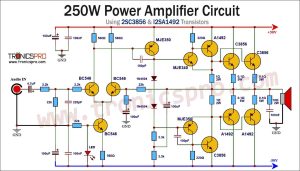Introduction
Reverse polarity is a common issue that occurs when the positive and negative terminals of a battery or power supply are connected incorrectly. This can lead to damaging consequences, such as electronic component failure or even electrical hazards. To prevent such mishaps, a reverse polarity protection circuit is essential. In this article, we will discuss the concept of reverse polarity protection and focus specifically on a popular component used in this circuit, the IRF9540 MOSFET.

Circuit Diagram of Reverse Polarity Protection Circuit
This project can be designed using a few basic components. The circuit diagram of this project is shown below.
More Circuit Layouts








Components List of Reverse Polarity Protection Circuit
Following is the list of all components used in this project:
- 1X IRF9540 MOSFET
- 2X LED
- 2X 1K RESISTORS
- 2X 10K RESISTORS
- 2X 2 PIN TERMINAL BLOCKS
- 1X PERF BOARD
- JUMPER WIRES
Explanation of Reverse Polarity Protection Circuit
I. Understanding Reverse Polarity Protection Circuit
Reverse polarity protection is a circuit designed to prevent damage caused by connecting a power supply or battery with incorrect polarity. When the polarity is reversed, it can result in a short circuit that may damage sensitive electronic components.
The reverse polarity protection works by detecting the polarity of the input voltage and preventing it from reaching the load if it is reversed. It consists of a diode, a fuse, and a MOSFET. The diode is placed in series with the circuit and allows the current to flow only in the correct direction. The fuse acts as a safety measure and burns out in case of a reverse polarity connection.
The MOSFET (Metal-Oxide-Semiconductor Field-Effect Transistor) is the key component of the reverse polarity protection circuit. It acts as a switch and cuts off the current flow when the polarity is reversed. The IRF9540 MOSFET is widely used in reverse polarity protection circuits due to its excellent performance and reliability.
II. Introduction to IRF9540 MOSFET
The IRF9540 MOSFET is a P-channel power MOSFET designed for high-performance applications. It features a low on-resistance and can handle high current and voltage levels. The IRF9540 is housed in a TO-220AB package, making it easy to mount on a PCB (Printed Circuit Board).
The key specifications of the IRF9540 MOSFET are as follows:
- Drain-Source Voltage (VDS): The maximum voltage that can be applied between the drain and the source terminals. For the IRF9540, this value is 100V.
- Drain Current (ID): The maximum current that can flow through the drain terminal. The IRF9540 can handle currents up to 22A.
- On-state Resistance (RDS(ON)): The resistance between the drain and source terminals when the MOSFET is fully conducting. The IRF9540 offers a low on-resistance of 0.117Ω.
- Gate Threshold Voltage (VGS(th)): The voltage at which the MOSFET starts to conduct. For the IRF9540, this value ranges from -2V to -4V.
The IRF9540 is designed to be used in high-power applications where low conduction losses and efficient power transfer are key considerations. Its high current and voltage handling capabilities, along with its low on-resistance, make it an ideal choice for reverse polarity protection circuits.
III. Benefits of Using IRF9540 MOSFET in Reverse Polarity Protection Circuit
- High Current Handling: The IRF9540 MOSFET can handle currents up to 22A, making it suitable for applications with demanding power requirements.
- Low On-resistance: The low on-resistance of 0.117Ω ensures minimal power losses and efficient power transfer in the reverse polarity protection circuit.
- Fast Switching Speed: The IRF9540 has a fast switching speed, allowing it to quickly cut off the current when a reverse polarity condition is detected. This helps in preventing damage to the connected load.
- Temperature Stability: The MOSFET is designed to operate reliably over a wide temperature range, ensuring stable performance even in harsh environments.
- Easy to Mount: The TO-220AB package of the IRF9540 makes it easy to mount on a PCB, simplifying the integration process in reverse polarity protection circuits.
Conclusion of Reverse Polarity Protection Circuit
Reverse polarity protection is crucial in preventing damage to electronic components and ensuring the safety of electrical systems. The IRF9540 MOSFET is an excellent choice for reverse polarity protection circuits due to its high current and voltage handling capabilities, low on-resistance, and fast switching speed.
When designing a reverse polarity protection circuit, it is essential to carefully select components that can handle the required power levels and provide reliable performance. The IRF9540 MOSFET provides these attributes and offers an efficient solution for protecting sensitive electronic devices from reverse polarity incidents.
In conclusion, the IRF9540 MOSFET is a highly reliable and efficient component used in reverse polarity protection circuits. Its excellent specifications, temperature stability, and ease of mounting make it a popular choice among engineers and designers. By incorporating the IRF9540 MOSFET into reverse polarity protection circuits, potential damage and hazards caused by reverse polarity connections can be mitigated effectively, ensuring the longevity and safety of electronic systems.
More projects, You may like:
- Video Transmitter DIY Homemade FM Radio Transmitter
- Adjustable Power Supply DIY Battery Charger
- 12V-220V 500 Watt inverter DIY Homemade
- 12V-220V H-Bridge Inverter DIY Homemade
- MPPT Solar Charge Controller DIY Homemade
- 18650 battery bank free charge protection module
- D718 B688 Bass Amplifier Homemade DIY
- C5200 Bass Amplifier DIY Homemade with Volume
- DIY LA4440 bass amplifier homemade
- C5200 A1943 TDA2030 Amplifier DIY Homemade
For more projects and circuit diagrams, you can go through the Schematics in the main menu where you can find many interesting projects and circuit diagrams like audio amplifier circuits, voltage booster circuit, battery charger circuit and timer circuits etc., which are all beginner circuit projects. Feel free to check them out!
Thanks for visiting the article and watching the video.



























